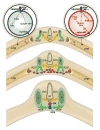Arterial versus venous endothelial cells
- PMID: 18972135
- PMCID: PMC4105978
- DOI: 10.1007/s00441-008-0706-5
Arterial versus venous endothelial cells
Abstract
Vascular endothelial cells (ECs) form the inner lining of all blood vessels from the largest artery and veins, viz., the aorta and venae cavae, respectively, to the capillaries that connect the arterial and venous systems. Because these two major conducting systems of the cardiovasculature differ functionally, it is not surprising that the physical makeup of arteries and veins, including the ECs that line their lumina, are also distinct. Although few would argue that the local environment contributes to the differences between arteries and veins, recent evidence has shown that the specification of arterial and venous identity is largely genetically determined.
Figures



References
-
- Ahn DG, Ruvinsky I, Oates AC, Silver LM, Ho RK. tbx20, a new vertebrate T-box gene expressed in the cranial motor neurons and developing cardiovascular structures in zebrafish. Mech Dev. 2000;95:253–258. - PubMed
-
- Aird WC. Phenotypic heterogeneity of the endothelium. I. Structure, function, and mechanisms. Circ Res. 2007;100:158–173. - PubMed
-
- Alon T, Hemo I, Itin A, Pe’er J, Stone J, Keshet E. Vascular endothelial growth factor acts as a survival factor for newly formed retinal vessels and has implications for retinopathy of prematurity. Nat Med. 1995;1:1024–1028. - PubMed
-
- Artavanis-Tsakonas S, Rand MD, Lake RJ. Notch signaling: cell fate control and signal integration in development. Science. 1999;284:770–776. - PubMed
Publication types
MeSH terms
Grants and funding
LinkOut - more resources
Full Text Sources
Other Literature Sources

